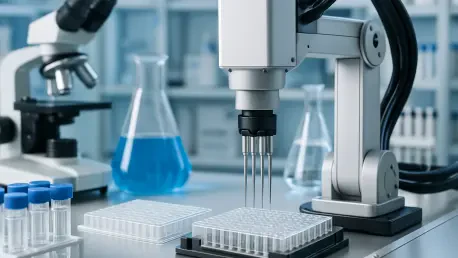In an era where the global population continues to age and expand, the life sciences industry faces unprecedented pressure to deliver faster, more reliable solutions for healthcare, diagnostics, and pharmaceutical development, while automation emerges as a transformative force. This technology is revolutionizing how the sector operates by enhancing productivity and ensuring precision in processes that were once labor-intensive. From laboratories to biotech firms, the adoption of automated technologies is not merely a trend but a necessity to keep pace with rising demand. This shift is driven by the need to address critical challenges, such as an increase in chronic illnesses and the demand for innovative medical technologies. As companies strive to meet these needs without sacrificing quality or escalating costs, automation stands out as a game-changer, promising efficiency and consistency. The impact of this technological evolution is already reshaping the landscape of life sciences, opening up significant market opportunities for those at the forefront of innovation.
Driving Forces Behind Automation in Life Sciences
The surge in automation within life sciences is largely fueled by demographic shifts that have intensified the demand for medical care and advanced healthcare solutions. An aging global population, coupled with overall growth in numbers, has created a pressing need for more laboratory testing, faster drug development, and cutting-edge medical technologies. These societal changes mean that traditional manual processes are no longer sufficient to handle the volume and complexity of tasks required. Automation steps in to streamline repetitive activities, such as sample handling in diagnostics or production in pharmaceuticals, reducing the risk of human error while accelerating turnaround times. This technological integration ensures that critical health-related outcomes are achieved with greater reliability, addressing the urgent needs of a world where longer lifespans often correlate with a higher prevalence of illness.
Beyond demographics, the push for automation is also rooted in the pursuit of quality and consistency, which are non-negotiable in life sciences. Automated systems excel at performing tasks with uniformity, whether it’s processing thousands of test samples or manufacturing medical devices. This capability is vital in an industry where even minor deviations can have significant consequences for patient safety and treatment efficacy. By minimizing the need for rework and ensuring precision, automation not only boosts operational efficiency but also builds trust in the outcomes of scientific and medical endeavors. As the sector continues to evolve, the ability to maintain high standards under increasing pressure remains a key reason why automation is becoming indispensable across various applications, from research labs to production floors.
Economic Advantages and Scalability of Automation
One of the most compelling reasons for the widespread adoption of automation in life sciences is its potential for cost efficiency. As workloads grow due to rising healthcare demands, companies face the challenge of scaling operations without incurring proportional increases in expenses. Automated solutions provide an answer by enabling organizations to handle larger volumes of tasks—be it conducting diagnostic tests or producing pharmaceuticals—without a corresponding spike in labor or operational costs. This economic benefit allows firms to allocate resources more strategically, investing in innovation rather than merely expanding their workforce. The financial incentive is clear: automation offers a sustainable path to growth in an industry often constrained by tight budgets and regulatory demands.
Additionally, the scalability offered by automation is transforming how life sciences entities approach market expansion. With automated systems, companies can adapt to fluctuating demands with ease, ramping up production or testing capacities during peak periods without the delays associated with manual processes. This flexibility is particularly crucial in responding to public health crises or sudden surges in need for specific medical solutions. Moreover, automation reduces the downtime and errors that often plague manual workflows, ensuring that resources are used optimally. As a result, businesses can maintain competitiveness in a global market where speed and reliability are paramount. The economic and operational advantages of automation are thus not just short-term fixes but long-term strategies for success in a rapidly evolving sector.
Global Innovation and Regional Adaptation
Automation in life sciences is not a one-size-fits-all solution; it requires tailored approaches to meet diverse regional and industrial needs. Leading companies in this space, with specialized divisions focusing on life sciences, often operate through global engineering hubs that develop region-specific innovations. These centers create pneumatic and electric solutions designed for applications ranging from laboratory diagnostics to medical technology production. By aligning their offerings with local market demands, such firms ensure that automation technologies are both relevant and effective across different geographies. This global yet localized strategy highlights the importance of adaptability in driving the widespread acceptance of automated systems.
Furthermore, the cross-pollination of expertise from industrial automation to life sciences has spurred remarkable advancements, particularly in areas like miniaturization for diagnostics. Technologies honed in other sectors are being repurposed to enhance efficiency and precision in healthcare-related applications. This transfer of knowledge ensures that life sciences benefit from proven methodologies, maintaining stringent quality standards essential for human health. The result is a dynamic ecosystem where innovation is not confined to a single field but enriched by broader technological progress. As automation continues to bridge gaps between industries and regions, it fosters a collaborative environment where solutions are continuously refined to address the unique challenges faced by the life sciences sector.
Reflecting on Automation’s Lasting Impact
Looking back, the integration of automation into life sciences proved to be a pivotal shift that addressed some of the sector’s most pressing challenges. It tackled the strain of demographic changes by enhancing efficiency, upheld critical quality standards through precision, and offered economic relief by curbing operational costs. The journey of adopting automated technologies showcased how innovation could transform an industry under immense pressure to deliver more with limited resources. This evolution was not just about adopting new tools but about redefining how healthcare and scientific advancements were achieved. Moving forward, the focus should be on further refining these technologies to anticipate future needs, ensuring that automation continues to adapt to emerging health crises and market dynamics. Exploring partnerships and investing in research for next-generation solutions will be essential steps to sustain this momentum and secure a healthier, more efficient future for life sciences.









